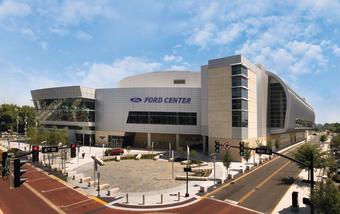FEATURE: Revitalizing a Struggling Downtown: A Long-Term Case Study
BY JOE J WALLACE
July 24, 2024
In the heart of many American cities lies a downtown area that was once bustling with commerce, culture, and community. Over the past six decades, however, numerous downtowns have faced significant challenges: retail stores shuttered, buildings stood vacant, and populations dwindled. Such was the case for the downtown in question. Fifteen years ago, the local government embarked on an ambitious plan to revitalize this struggling area. However, despite initial enthusiasm and some early successes, long-term outcomes have been disappointing, revealing the complexity of urban renewal.
The Initial Revitalization Initiative
In response to decades of decline, the local government launched a comprehensive revitalization plan. The centerpiece of this plan was the construction of a $128 million Sports and Entertainment arena. The Ford Center arena was touted as the key feature that would fill empty businesses, attract visitors, and pay for itself through generated revenue. Alongside the arena, the initiative included significant investment in infrastructure, business incentives, and public safety efforts.
Key Components Of The initial Downtown Improvement plan included:
- Ford Center Arena: A state-of-the-art facility intended to host sporting events, concerts, and other entertainment to draw large crowds downtown.
- Infrastructure Improvements: Upgrading roads, sidewalks, and public transportation to make the downtown more accessible and appealing.
- Business Incentives: Offering tax breaks, grants, and low-interest loans to attract new businesses and support existing ones.
- Public Safety Enhancements: Increasing police presence and implementing community policing strategies to reduce crime.
- Cultural and Community Events: Organizing festivals, markets, and other events to draw people into the downtown area.
- Residential Development: Encouraging the construction of affordable housing to bring residents back into the city center.
The Short-Term Successes
In the early years, the revitalization initiative yielded promising results. The new arena brought in entertainment and sporting events that drew large crowds. New businesses opened, creating jobs and generating tax revenue. Cultural events and festivals brought people together, fostering a sense of community. The construction of affordable housing attracted some new residents, and public safety improvements led to a reduction in certain types of crime.
The Long-Term Realities
Despite these initial successes, the long-term outcomes have been far less encouraging. The downtown area continued to face significant challenges, revealing the limitations of the revitalization plan and the need for a more nuanced approach.
- Population Decline: Although new residential housing was developed, the downtown population continued to decrease. Many people were still hesitant to move back due to ongoing concerns about crime and the overall economic stability of the area. The new housing stock often remained underutilized, reflecting deeper demographic and economic trends that the revitalization plan failed to address.
- Lack of Essential Services: One of the most critical issues was that the downtown area never had a sufficient population to support fundamental needs like a grocery store, gas station, or pharmacy. Without these essential services, the area struggled to attract and retain residents, further exacerbating the population decline.
- Economic Volatility: While the initial wave of businesses brought some economic activity, many of these establishments, particularly restaurants, struggled to survive. A revolving door of failed businesses created an unstable economic environment, deterring further investment. The business incentives proved insufficient to ensure long-term sustainability, as underlying economic conditions remained unfavorable.
- Ford Center Arena Financial Issues: The Ford Center arena, intended as the linchpin of the revitalization effort, failed to deliver on its promises. Although it brought some good entertainment, it also incurred significant operating losses from day one, diverting funds from essential public services like fire and police. Moreover, the revenue generated by the arena was insufficient to cover the loan repayments, creating a financial burden on the city.
- Crime Rates: Public safety improvements had a limited long-term impact. Although petty theft decreased initially, more serious crimes persisted. The root causes of crime—poverty, unemployment, and social dislocation—remained largely unaddressed, limiting the overall effectiveness of these measures.
- Neglected Suburbs: As the local government focused resources and attention on the downtown area, the growing suburbs were largely ignored. This neglect led to a widening gap between the struggling urban core and the thriving suburban communities. Residents in the suburbs enjoyed better amenities, schools, and public services, further drawing people and investment away from the downtown.
- Wages and Employment: Although new jobs were created, wage growth remained sluggish. Many of the new positions were in the service sector, which typically offers lower wages and less job security. The issue of declining real wages persisted, exacerbating economic disparities and limiting the overall impact on the local economy.
Lessons Learned
The experiences of the past 15 years highlight several critical lessons for urban renewal efforts:
- Holistic Approach: Addressing infrastructure, business incentives, and public safety in isolation is insufficient. A comprehensive strategy that also tackles underlying social and economic issues is crucial for sustainable revitalization.
- Essential Services: Ensuring that the downtown has essential services like grocery stores, gas stations, and pharmacies is crucial for attracting and retaining residents.
- Community Involvement: Engaging residents and local businesses in the planning and implementation process ensures that the initiative reflects the community’s needs and aspirations.
- Suburban Inclusion: Ignoring the suburbs while focusing on downtown can create imbalances that undermine overall regional growth. A balanced approach that includes both urban and suburban areas is essential.
- Long-Term Commitment: Revitalizing a struggling downtown is a long-term endeavor that requires sustained effort and investment. Short-term gains must be balanced with strategies for long-term stability and growth.
- Financial Viability: Ensuring that major investments, like the FORD CENTER arena, are financially viable and do not drain resources from essential public services is critical for the success of such projects.
Moving Forward
To move forward, the local government must reassess its strategies and adopt a more inclusive and comprehensive approach. Addressing the root causes of economic and social challenges, investing in both urban and suburban areas, and fostering community involvement are essential steps. True revitalization requires a multifaceted journey requiring patience, commitment, and collaboration.
In conclusion, the initial revitalization efforts brought some short-term benefits but failed to address the deeper, long-term challenges facing the downtown area. The lack of essential services, persistent economic volatility, financial issues with the FORD CENTER arena, and neglect of the suburbs highlighted the need for a more holistic approach. The experiences from this initiative offer valuable insights for other cities striving to breathe new life into their downtowns, reminding us that true revitalization is a complex and ongoing process.
FOOTNOTE: “This article was written by Joe J. Wallace with assistance from a large language model using artificial intelligence through prompting”
The City-County Observer posted this article without bias or editing.






i remember when John Kisch the Ford Center project manager said on tv that this project would make money from day one. Now he is long gone and so is a lot of taxpayers dollars. The Ford Center will be obsolete and in falling down before it is ever paid off.
Agree. ……Nothing more nothing less than Payola for the local unions…….. without a doubt…..
This is a thoughtful, well-written article. Planning and executing a holistic approach to redevelopment is going to be a huge job for Mayor Terry and her administration, but I think she’s taking a good approach by listening to citizens’ concerns.
Comments are closed.